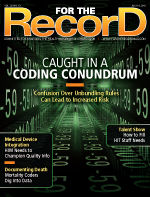 July 18, 2011
July 18, 2011
Coding for Aortic Conditions
For The Record
Vol. 23 No. 13 P. 28
The aorta is the largest artery in the body, originating at the left ventricle in the heart and ending in the abdominal area where the aorta divides into the two iliac arteries. The two most common problems that can affect the aorta are aneurysms and dissections, which may be caused by conditions such as atherosclerosis, hypertension, Marfan syndrome, connective tissue disorders, and injury.
Aortic Aneurysm
An aneurysm is a weak area of the artery wall where the diseased tissue does not stretch and contract well, causing a localized enlargement. The diameter of the enlargement determines whether it is considered an aneurysm. Typically, a permanent dilation of 4 cm in diameter is considered an aneurysm; anything less may be described as bulging, ballooning, or dilated. Other physicians may classify it as an aneurysm if the permanent enlargement is at least 1.5 times greater than its normal size.
Aneurysms are described according to location, size, and shape. Shapes include fusiform and saccular. Fusiform is when the aneurysm is enlarged equally in all directions; saccular is when the bulge or sac occurs on only one side of the aorta. Possible locations of an aortic aneurysm are as follows:
• Ascending (441.2); if ruptured, use 441.1;
• Arch (441.2); if ruptured, use 441.1;
• Descending, not otherwise specified (NOS) (441.9); if ruptured, use 441.5;
• Thoracic descending (441.2); if ruptured, use 441.1;
• Abdominal descending (441.4); if ruptured, use 441.3;
• Thoracoabdominal (441.7); if ruptured, use 441.6;
• Abdominal (441.4); if ruptured, use 441.3.
An abdominal aortic aneurysm is the most common type. If an aortic aneurysm is documented but not specified as to site, assign code 441.9. A ruptured aortic aneurysm, NOS is classified to code 441.5. A pseudoaneurysm (false aneurysm) is an aneurysm that does not have some or all of the aortic wall layers. Often due to an injury of inner aortic wall and an infection, a pseudoaneurysm is unpredictable and may rupture at smaller sizes. Pseudoaneurysm is classified to the same codes as the other aneurysms, depending on location.
Aortic Dissection
Aortic tissue may tear even without an aneurysm. Dissection is the tearing of the inner layer of a vessel that allows blood to leak between the inner and outer layers, possibly causing severe back or chest pain, pallor, pulselessness, paresthesiae, and paralysis. This life-threatening condition usually occurs in the ascending or descending part of the thoracic aorta but may also occur in the abdominal aorta. The physician may document this condition as dissecting aneurysm.
Dissecting aortic aneurysm or aortic dissection is classified to ICD-9-CM code 441.0x. The following fifth-digit subclassifications identify the site of the dissection:
• 441.00, Unspecified site;
• 441.01, Thoracic;
• 441.02, Abdominal; and
• 441.03, Thoracoabdominal.
Aortic dissections may be classified as type A or B. Type A is defined as involving the ascending aorta and usually requires surgical treatment. Type B does not involve the ascending aorta and may be managed medically.
The type of aortic dissection does not affect code assignment. The code assignment is only based on the site of the dissecting aneurysm (AHA Coding Clinic for ICD-9-CM, 1989, fourth quarter, page 10).
Diagnosis and Treatment
Aortic diseases are diagnosed using echocardiogram, transthoracic echocardiogram, transesophageal cardiogram, a CT scan, or MRI.
The treatment for aortic aneurysm and dissection depends on the location, size, and type. The condition may be treated with medications to control blood pressure. Common medications given include beta blockers, anticholergenic inhibitors, and calcium channel blockers.
Surgical treatment may involve resection of the aneurysm with replacement with a Dacron graft. The aortic valve may also be repaired or replaced. An endovascular repair may also treat aneurysms.
Coding and sequencing for aortic conditions are dependent on the physician documentation in the medical record and application of the Official Coding Guidelines for inpatient care. Also, use specific AHA Coding Clinic for ICD-9-CM and American Medical Association CPT Assistant references to ensure complete and accurate coding.
— This information was prepared by Audrey Howard, RHIA, of 3M Consulting Services. 3M Consulting Services is a business of 3M Health Information Systems, a supplier of coding and classification systems to more than 5,000 healthcare providers. The company and its representatives do not assume any responsibility for reimbursement decisions or claims denials made by providers or payers as the result of the misuse of this coding information. More information about 3M Health Information Systems is available at www.3mhis.com or by calling 800-367-2447.
ICD-10-CM Coding for Aortic Aneurysm and Dissection
The index and tabular list for aortic aneurysm and dissection is very similar in ICD-10-CM as in ICD-9-CM. The ICD-10-CM code assignments are as follows:
• I71.00, Dissection of unspecified site of aorta;
• I71.01, Dissection of thoracic aorta;
• I71.02, Dissection of abdominal aorta;
• I71.03, Dissection of thoracoabdominal aorta;
• I71.1, Thoracic aortic aneurysm, ruptured;
• I71.2, Thoracic aortic aneurysm, without rupture;
• I71.3, Abdominal aortic aneurysm, ruptured;
• I71.4, Abdominal aortic aneurysm, without rupture;
• I71.5, Thoracoabdominal aortic aneurysm, ruptured;
• I71.6, Thoracoabdominal aortic aneurysm, without rupture;
• I71.8, Aortic aneurysm of unspecified site, ruptured; and
• I71.9, Aortic aneurysm of unspecified site, without rupture.
The only difference is that “dissecting” is no longer a subterm under aneurysm in the ICD-10-CM index. Therefore, it would stand to reason that if a patient experienced a dissecting aortic aneurysm, two codes should be assigned to identify the entire diagnosis: one for the dissection and one for the aneurysm.
— Audrey Howard



